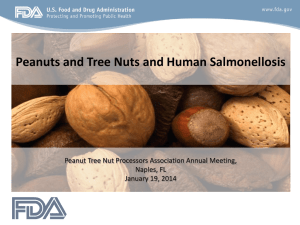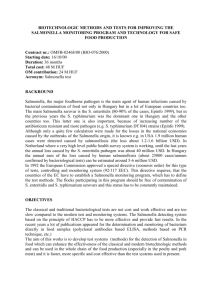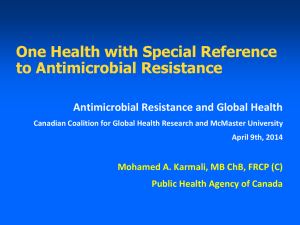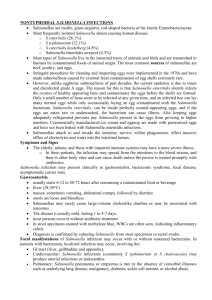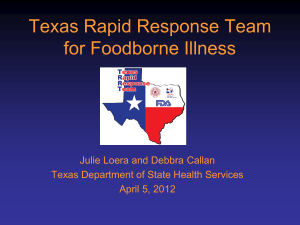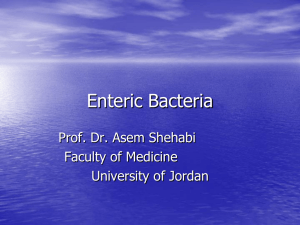ID 24i3 June 2015
advertisement
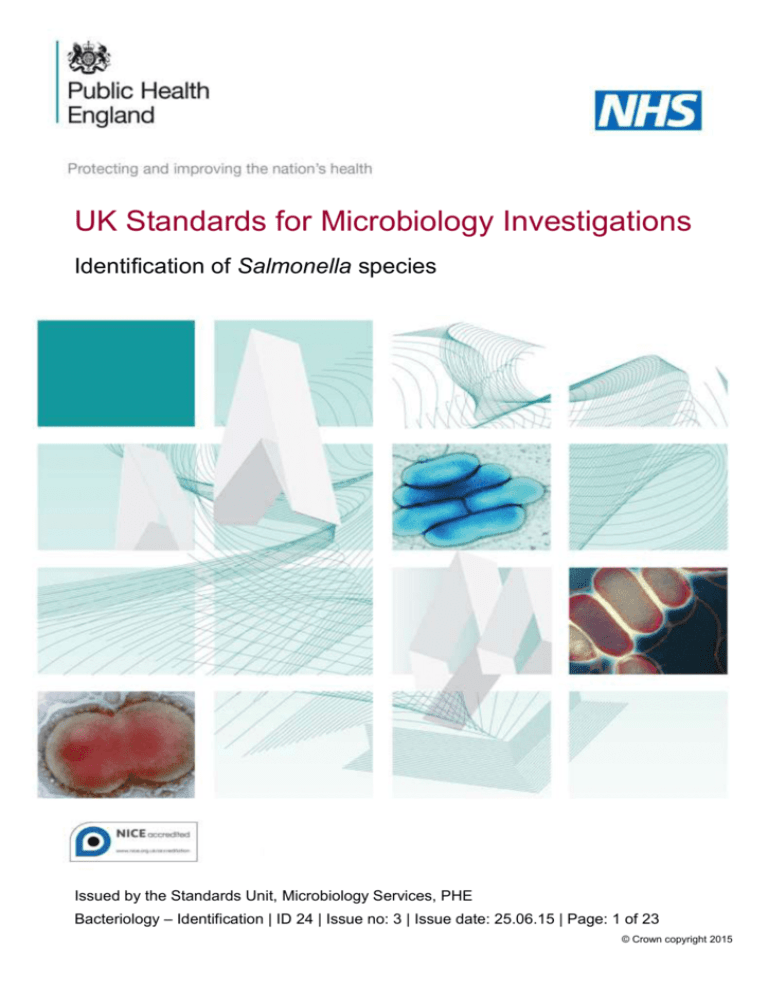
UK Standards for Microbiology Investigations Identification of Salmonella species Issued by the Standards Unit, Microbiology Services, PHE Bacteriology – Identification | ID 24 | Issue no: 3 | Issue date: 25.06.15 | Page: 1 of 23 © Crown copyright 2015 Identification of Salmonella species Acknowledgments UK Standards for Microbiology Investigations (SMIs) are developed under the auspices of Public Health England (PHE) working in partnership with the National Health Service (NHS), Public Health Wales and with the professional organisations whose logos are displayed below and listed on the website https://www.gov.uk/ukstandards-for-microbiology-investigations-smi-quality-and-consistency-in-clinicallaboratories. SMIs are developed, reviewed and revised by various working groups which are overseen by a steering committee (see https://www.gov.uk/government/groups/standards-for-microbiology-investigationssteering-committee). The contributions of many individuals in clinical, specialist and reference laboratories who have provided information and comments during the development of this document are acknowledged. We are grateful to the Medical Editors for editing the medical content. For further information please contact us at: Standards Unit Microbiology Services Public Health England 61 Colindale Avenue London NW9 5EQ E-mail: standards@phe.gov.uk Website: https://www.gov.uk/uk-standards-for-microbiology-investigations-smi-qualityand-consistency-in-clinical-laboratories PHE Publications gateway number: 2015013 UK Standards for Microbiology Investigations are produced in association with: Logos correct at time of publishing. Bacteriology – Identification | ID 24 | Issue no: 3 | Issue date: 25.06.15 | Page: 2 of 23 UK Standards for Microbiology Investigations | Issued by the Standards Unit, Public Health England Identification of Salmonella species Contents ACKNOWLEDGMENTS .......................................................................................................... 2 CONTENTS ............................................................................................................................. 3 AMENDMENT TABLE ............................................................................................................. 4 UK STANDARDS FOR MICROBIOLOGY INVESTIGATIONS: SCOPE AND PURPOSE ....... 6 SCOPE OF DOCUMENT ......................................................................................................... 9 INTRODUCTION ..................................................................................................................... 9 TECHNICAL INFORMATION/LIMITATIONS ......................................................................... 10 1 SAFETY CONSIDERATIONS .................................................................................... 11 2 TARGET ORGANISMS .............................................................................................. 11 3 IDENTIFICATION ....................................................................................................... 11 4 IDENTIFICATION OF SALMONELLA SPECIES ....................................................... 17 5 REPORTING .............................................................................................................. 18 6 REFERRALS.............................................................................................................. 19 7 NOTIFICATION TO PHE OR EQUIVALENT IN THE DEVOLVED ADMINISTRATIONS .................................................................................................. 19 REFERENCES ...................................................................................................................... 21 Bacteriology – Identification | ID 24 | Issue no: 3 | Issue date: 25.06.15 | Page: 3 of 23 UK Standards for Microbiology Investigations | Issued by the Standards Unit, Public Health England Identification of Salmonella species Amendment table Each SMI method has an individual record of amendments. The current amendments are listed on this page. The amendment history is available from standards@phe.gov.uk. New or revised documents should be controlled within the laboratory in accordance with the local quality management system. Amendment No/Date. 6/25.06.15 Issue no. discarded. 2.3 Insert Issue no. 3 Section(s) involved Amendment Whole document. Hyperlinks to gov.uk added. Page 2. Updated logos added. The taxonomy of Salmonella species has been updated. Introduction. More information has been added to the Characteristics section. The medically important species of Salmonella are mentioned. Section on Principles of Identification has been updated to include the MALDI-TOF. Technical information/limitations. Addition of information regarding quality control, commercial identification systems and MALDI-TOF MS. Safety considerations. This section has been updated on the handling of Salmonella species as well as laboratory acquired infections. Target organisms. The section on the Target organisms has been updated and presented clearly. Updates have been done on 3.2, 3.3 and 3.4 to reflect standards in practice. Identification. Section 3.4.2, 3.4.3 and 3.4.4 has been updated to include Commercial Identification Systems, MALDI-TOF MS and NAATs with references. Subsection 3.5 has been updated to include the Rapid Molecular Methods. Identification flowchart. Modification of flowchart for identification of Salmonella species has been done for easy guidance. Bacteriology – Identification | ID 24 | Issue no: 3 | Issue date: 25.06.15 | Page: 4 of 23 UK Standards for Microbiology Investigations | Issued by the Standards Unit, Public Health England Identification of Salmonella species Reporting. Subsection 5.3 has been updated to reflect the information required on reporting practice. Referral. The addresses of the reference laboratories have been updated. References. Some references updated. Bacteriology – Identification | ID 24 | Issue no: 3 | Issue date: 25.06.15 | Page: 5 of 23 UK Standards for Microbiology Investigations | Issued by the Standards Unit, Public Health England Identification of Salmonella species UK Standards for Microbiology Investigations: scope and purpose Users of SMIs SMIs are primarily intended as a general resource for practising professionals operating in the field of laboratory medicine and infection specialties in the UK. SMIs provide clinicians with information about the available test repertoire and the standard of laboratory services they should expect for the investigation of infection in their patients, as well as providing information that aids the electronic ordering of appropriate tests. SMIs provide commissioners of healthcare services with the appropriateness and standard of microbiology investigations they should be seeking as part of the clinical and public health care package for their population. Background to SMIs SMIs comprise a collection of recommended algorithms and procedures covering all stages of the investigative process in microbiology from the pre-analytical (clinical syndrome) stage to the analytical (laboratory testing) and post analytical (result interpretation and reporting) stages. Syndromic algorithms are supported by more detailed documents containing advice on the investigation of specific diseases and infections. Guidance notes cover the clinical background, differential diagnosis, and appropriate investigation of particular clinical conditions. Quality guidance notes describe laboratory processes which underpin quality, for example assay validation. Standardisation of the diagnostic process through the application of SMIs helps to assure the equivalence of investigation strategies in different laboratories across the UK and is essential for public health surveillance, research and development activities. Equal partnership working SMIs are developed in equal partnership with PHE, NHS, Royal College of Pathologists and professional societies. The list of participating societies may be found at https://www.gov.uk/uk-standards-formicrobiology-investigations-smi-quality-and-consistency-in-clinical-laboratories. Inclusion of a logo in an SMI indicates participation of the society in equal partnership and support for the objectives and process of preparing SMIs. Nominees of professional societies are members of the Steering Committee and Working Groups which develop SMIs. The views of nominees cannot be rigorously representative of the members of their nominating organisations nor the corporate views of their organisations. Nominees act as a conduit for two way reporting and dialogue. Representative views are sought through the consultation process. SMIs are developed, reviewed and updated through a wide consultation process. Microbiology is used as a generic term to include the two GMC-recognised specialties of Medical Microbiology (which includes Bacteriology, Mycology and Parasitology) and Medical Virology. Bacteriology – Identification | ID 24 | Issue no: 3 | Issue date: 25.06.15 | Page: 6 of 23 UK Standards for Microbiology Investigations | Issued by the Standards Unit, Public Health England Identification of Salmonella species Quality assurance NICE has accredited the process used by the SMI Working Groups to produce SMIs. The accreditation is applicable to all guidance produced since October 2009. The process for the development of SMIs is certified to ISO 9001:2008. SMIs represent a good standard of practice to which all clinical and public health microbiology laboratories in the UK are expected to work. SMIs are NICE accredited and represent neither minimum standards of practice nor the highest level of complex laboratory investigation possible. In using SMIs, laboratories should take account of local requirements and undertake additional investigations where appropriate. SMIs help laboratories to meet accreditation requirements by promoting high quality practices which are auditable. SMIs also provide a reference point for method development. The performance of SMIs depends on competent staff and appropriate quality reagents and equipment. Laboratories should ensure that all commercial and in-house tests have been validated and shown to be fit for purpose. Laboratories should participate in external quality assessment schemes and undertake relevant internal quality control procedures. Patient and public involvement The SMI Working Groups are committed to patient and public involvement in the development of SMIs. By involving the public, health professionals, scientists and voluntary organisations the resulting SMI will be robust and meet the needs of the user. An opportunity is given to members of the public to contribute to consultations through our open access website. Information governance and equality PHE is a Caldicott compliant organisation. It seeks to take every possible precaution to prevent unauthorised disclosure of patient details and to ensure that patient-related records are kept under secure conditions. The development of SMIs are subject to PHE Equality objectives https://www.gov.uk/government/organisations/public-health-england/about/equalityand-diversity. The SMI Working Groups are committed to achieving the equality objectives by effective consultation with members of the public, partners, stakeholders and specialist interest groups. Legal statement Whilst every care has been taken in the preparation of SMIs, PHE and any supporting organisation, shall, to the greatest extent possible under any applicable law, exclude liability for all losses, costs, claims, damages or expenses arising out of or connected with the use of an SMI or any information contained therein. If alterations are made to an SMI, it must be made clear where and by whom such changes have been made. The evidence base and microbial taxonomy for the SMI is as complete as possible at the time of issue. Any omissions and new material will be considered at the next review. These standards can only be superseded by revisions of the standard, legislative action, or by NICE accredited guidance. SMIs are Crown copyright which should be acknowledged where appropriate. Bacteriology – Identification | ID 24 | Issue no: 3 | Issue date: 25.06.15 | Page: 7 of 23 UK Standards for Microbiology Investigations | Issued by the Standards Unit, Public Health England Identification of Salmonella species Suggested citation for this document Public Health England. (2015). Identification of Salmonella species. UK Standards for Microbiology Investigations. ID 24 Issue 3. https://www.gov.uk/uk-standards-formicrobiology-investigations-smi-quality-and-consistency-in-clinical-laboratories Bacteriology – Identification | ID 24 | Issue no: 3 | Issue date: 25.06.15 | Page: 8 of 23 UK Standards for Microbiology Investigations | Issued by the Standards Unit, Public Health England Identification of Salmonella species Scope of document This SMI describes the identification of Salmonella species. The majority of Salmonellae are isolated from faeces but the organism may be isolated from other specimens such as blood, bone marrow and urine. This SMI should be used in conjunction with other SMIs. Introduction Taxonomy There are currently 2 validly published species and 6 subspecies. They are Salmonella bongori, Salmonella enterica and its subspecies - Salmonella enterica subspecies arizonae, Salmonella enterica subspecies diarizonae, Salmonella enterica subspecies enterica, Salmonella enterica subspecies houtenae, Salmonella enterica subspecies indica and Salmonella enterica subspecies salamae1. All validly published names, even if they are not cited in the above list can still be used by bacteriologists. These include Salmonella Enteritidis, Salmonella Paratyphi, Salmonella Typhi and Salmonella Typhimurium (even though they have been classed as serotypes). Salmonella subterranean was recently removed from the genus because it is closely related to Escherichia hermannii and does not belong to the genus Salmonella1. The nomenclature adopted in this SMI follows the advice from the Judicial Commission of the International Committee on Systematics of Prokaryotes2. It is likely however, that laboratories will continue to report serotypes as species for some time to come3. Characteristics Cells are rod-shaped, non-spore-forming, and predominantly motile by means of peritrichous flagella with diameters of around 0.7-1.5μm and lengths of 2-5μm with a few exceptions. On blood agar, colonies are 2-3mm in diameter. Colonies are generally lactose non-fermenters. They obtain their energy from oxidation and reduction reactions using organic sources, and are facultative anaerobes. They produce acid from glucose usually with the production of gas, and are oxidase negative3. Most produce hydrogen sulphide except Salmonella Paratyphi A and Salmonella Typhi, which is a weak producer. They are identified with a combination of serological and biochemical tests. Salmonella species are classified and identified into serotypes according to the WhiteKauffmann-Le Minor scheme; there are more than 2,500 Salmonella serotypes that have been described and reported4,5. Presently, new serotypes are being discovered each year, adding to the complexity of this large bacterial population. Primary subdivision is into “O” serogroups (those which share a common somatic antigen), and these are then subdivided on the basis of “H” (flagella) antigens 4. Strains of Salmonella Typhi may produce Vi antigen, which is an acidic polysaccharide layer outside the cell wall. When fully developed, it renders the bacteria agglutinable with Vi antiserum and inagglutinable with “O” antiserum. Antigens similar to Vi may also be found in some strains of Salmonella Paratyphi C and Salmonella Dublin. Bacteriology – Identification | ID 24 | Issue no: 3 | Issue date: 25.06.15 | Page: 9 of 23 UK Standards for Microbiology Investigations | Issued by the Standards Unit, Public Health England Identification of Salmonella species All Salmonella serotypes are considered potentially pathogenic. Some serotypes are host-specific, but the majority can affect different hosts. Most Salmonella serotypes possess two phases of H (flagellar) antigens: phase 1, phase 2 or may have both phases simultaneously. Cultures that are not expressed in one phase upon primary culture may be switched to the other phase using a Craigie’s tube or another medium to enhance motility before the H antigens can be detected6,7. Salmonella Enteritidis and Salmonella Typhimurium are the two dominant serotypes of salmonellosis transmitted from animals to humans in most parts of the world. Salmonella Typhi and Salmonella Paratyphi A, B and C are the most common causes of enteric fever in humans. Salmonella species are found in faeces, blood, bile, urine, food and feed and environmental materials. The type species is Salmonella enterica. Principles of identification Isolates are identified by a combination of colonial appearance, serology (agglutination with specific antisera) and biochemical testing. If confirmation of identification is required, isolates should be sent to the Reference Laboratory. Technical information/limitations Quality control If using commercially manufactured antisera, check suitability of use for all methods. Each new lot or shipment of antisera/commercial identification systems should be tested and validated for positive and negative reactivity using known control strains, ensuring it is fit for purpose. Laboratories must follow manufacturer’s instructions when using these products. Agglutination test Salmonella species should agglutinate with Polyvalent O antiserum. Some serotypes eg Salmonella Typhi may produce a Vi antigen, which can prevent agglutination with Polyvalent O antiserum. Not all O serotypes are included in Polyvalent O antisera. H antigens may not be well developed on some solid agars and so sub-culturing onto a semi-solid agar may be necessary. Where results are inconclusive, it may be necessary to perform additional biochemical tests6,7. For slide agglutinations, growth on solid media is not optimal for the formation of flagella. False negative results may be obtained with H antisera. Inoculation of the pure culture to a wet nutrient agar slope will aid flagellum formation. MALDI-TOF MS As a tool for subspecies and serovar typing of Salmonella, MALDI-TOF MS shows significant promise but will require additional studies and modifications to existing protocols before the method can be used as a stand-alone mechanism8,9. Bacteriology – Identification | ID 24 | Issue no: 3 | Issue date: 25.06.15 | Page: 10 of 23 UK Standards for Microbiology Investigations | Issued by the Standards Unit, Public Health England Identification of Salmonella species 1 Safety considerations10-26 Most Salmonella species are in Hazard Group 2 with important exceptions including Salmonella Typhi and Salmonella Paratyphi A, B & C. All work on suspected S. Typhi and S. Paratyphi A, B & C must be performed under Containment level 3 conditions. S. Typhi, and S. Paratyphi A, B & C cause severe and sometimes fatal disease. The infectious dose varies with the serotype. Laboratory acquired infections have been reported- until 1974, 258 cases and 20 deaths due to laboratory-acquired typhoid fever were reported. Forty eight cases of salmonellosis were reported until 1976. Sixty four cases and 2 deaths due to Salmonella species infections were reported between 1979 and 2004, most of them associated with S. Typhi27-29. S. Typhi vaccines are available; guidance is available from the Department of Health30. Refer to current guidance on the safe handling of all Hazard Group 2 organisms documented in this SMI. Appropriate personal protective equipment (PPE) and techniques designed to minimise exposure of the laboratory workers should be worn and adhered to at all time. The most effective method for preventing laboratory-acquired infections is the adoption of safe working practices. Laboratory procedures that give rise to infectious aerosols must be conducted in a microbiological safety cabinet. The above guidance should be supplemented with local COSHH and risk assessments. Compliance with postal and transport regulations is essential and should be verified. 2 Target organisms Most common serotypes of Salmonella isolated and known to cause infections in humans Salmonella Enteritidis (1,9,12:g, m:-), Salmonella Typhimurium (1,4,5, 12:i: 1,2), Salmonella Virchow (6,7:r: 1,2), Salmonella Hadar (6,8:z10: e, n, x), Salmonella Heidelberg (1,4,5,12:r: 1,2), Salmonella Newport (6,8:e, h: 1,2), Salmonella Infantis (6,7:r: 1,5), Salmonella Agona (4,12:f, g, s:-), Salmonella Paratyphi A (1,2,12:a: 1,2), Salmonella Paratyphi B (1,4,5,12:b: 1,2), Salmonella Paratyphi C (6,7,Vi: c: 1,5), Salmonella Typhi (9,12,Vi: d:-) 3 Identification 3.1 Microscopic appearance Gram stain TP 39 - Staining procedures Gram negative rods 3.2 Primary isolation media Blood agar incubated in 5-10% CO2 at 35–37°C for 18-24hr. Bacteriology – Identification | ID 24 | Issue no: 3 | Issue date: 25.06.15 | Page: 11 of 23 UK Standards for Microbiology Investigations | Issued by the Standards Unit, Public Health England Identification of Salmonella species Cystine-lactose-electrolyte deficient (CLED) agar incubated in air at 35–37°C for 1824hr. Xylose-lysine-desoxycholate agar (XLD) agar incubated in air at 35–37°C for 18-24hr. Desoxycholate citrate (DCA) agar incubated in air at 35–37°C for 18-24hr. Brilliant Green agar (BGA) incubated in air at 35–37°C for 18-24hr. Other commercial validated media may be used. 3.3 Colonial appearance Blood agar - Colonies are moist and 2-3mm in diameter. CLED agar - Salmonella species are non-lactose fermenters (some serotypes eg Salmonella Arizonae and Salmonella Indiana may ferment lactose). XLD agar – Colonies are red, and usually with a black centre (some serotypes eg Salmonella Paratyphi A and Salmonella Typhi may not produce a black centre). DCA agar - Colonies are colourless, and usually with a black centre (some serotypes eg Salmonella Paratyphi A and Salmonella Typhi may not produce a black centre). BGA agar - Colonies appear as red-pink, 1-3mm in diameter, surrounded by brilliant red zones in the agar. 3.4 Test procedures 3.4.1 Agglutination Agglutination Test for Salmonella species (TP 3 - Agglutination test for Salmonella species) Salmonella species should agglutinate with Polyvalent O antiserum. Some serotypes eg Salmonella Typhi may produce a Vi antigen, which can prevent agglutination with Polyvalent O antiserum. Not all O serotypes are included in Polyvalent O antisera. H antigens may not be well developed on some solid agar and so sub-culturing onto a semi-solid agar may be necessary. Where results are inconclusive, it may be necessary to perform additional biochemical tests6,7. The following limited ranges of antisera are adequate for routine use: Polyvalent O Single factor O (2, 4, 6:7, 8, 9, 3:10) Polyvalent H Rapid H sera (RSD 1, 2, 3) Polyvalent H phase 2 (1-7) Single factor H (a, b, c, d, E, G, i, r) Changing the Phase of Salmonella (TP 32 - Changing the phase of Salmonella) optional The majority of serotypes of Salmonella possess two phases of H (flagellar) antigens phase 1, phase 2 or may have both phases simultaneously. If agglutination is obtained with only one phase, the organism may be induced to change to the other Bacteriology – Identification | ID 24 | Issue no: 3 | Issue date: 25.06.15 | Page: 12 of 23 UK Standards for Microbiology Investigations | Issued by the Standards Unit, Public Health England Identification of Salmonella species phase. Some serotypes eg Salmonella Typhi and Salmonella Montevideo have only one phase and so these should be sent to the Reference Laboratory6,7. 3.4.2 Biochemical tests Urease TP 36 - Urease test Salmonella species do not produce urease Oxidase TP 26 - Oxidase test Salmonella species are oxidase negative Indole Test TP19 – Indole test Salmonella species are indole negative Commercial identification systems Many rapid confirmation and identification methods have been developed for Salmonella and a large number have been developed into commercial products. Biochemical confirmation can be accomplished using commercial identification systems. Rapid immunological identification and confirmation tests based on latex agglutination, enzyme immunoassay (EIA) and enzyme-linked immunosorbent assay (ELISA) have been developed for Salmonella, and simple-to-use lateral flow test strips using immunochromatographic technology have also been developed into commercial products by a number of manufacturers. Laboratories should follow manufacturer’s instructions and rapid tests and kits should be validated and be shown to be fit for purpose prior to use. 3.4.3 Matrix-assisted laser desorption/ionisation time of flight mass spectrometry (MALDI-TOF MS) Matrix-assisted laser desorption ionization time of flight mass spectrometry (MALDITOF MS), which can be used to analyse the protein composition of a bacterial cell, has emerged as a new technology for species identification. This has been shown to be a rapid and powerful tool because of its reproducibility, speed and sensitivity of analysis. The advantage of MALDI-TOF as compared with other identification methods is that the results of the analysis are available within a few hours rather than several days. The speed and the simplicity of sample preparation and result acquisition associated with minimal consumable costs make this method well suited for routine and high-throughput use31. This has been utilised to aid in both the detection and species-level identification of Salmonella. It has also been used in discriminating S. enterica serovar Typhi from other Salmonella serovars. As a tool for subspecies and serovar typing, MALDI-TOF MS shows significant promise but will require additional studies and modifications to existing protocols before the method can be used as a stand-alone mechanism8,9. 3.4.4 Nucleic acid amplification tests (NAATs) PCR is usually considered to be a good method for bacterial detection as it is simple, rapid, sensitive and specific. The basis for PCR diagnostic applications in microbiology is the detection of infectious agents and the discrimination of non-pathogenic from pathogenic strains by virtue of specific genes. However, it does have limitations. Bacteriology – Identification | ID 24 | Issue no: 3 | Issue date: 25.06.15 | Page: 13 of 23 UK Standards for Microbiology Investigations | Issued by the Standards Unit, Public Health England Identification of Salmonella species Although the 16S rRNA gene is generally targeted for the design of species-specific PCR primers for identification, designing primers is difficult when the sequences of the homologous genes have high similarity. This has been used successfully in the identification of Salmonella subspecies I, Salmonella enterica serovars Typhimurium, Typhi and Enteritidis as well as Salmonella enterica subspecies arizonae and diarizonae (rapidly and accurately without the need for serological testing)5,32-34. Multiplex PCR may sometimes be complex and lack reproducibility between laboratories because of the specific conditions needed for simultaneous amplification of several regions. However, more evaluation needs to be done with varieties of Salmonella serovars in conjunction with other laboratories in order to demonstrate accuracy of Salmonella identification in epidemiological and taxonomical studies 5,35. 3.5 Further identification Rapid molecular methods Molecular methods have had an enormous impact on the taxonomy of Salmonella. Analysis of gene sequences has increased understanding of the phylogenetic relationships of Salmonella and related organisms; and has resulted in the recognition of numerous new species. Molecular techniques have made identification of many species more rapid and precise than is possible with phenotypic techniques. A variety of subtyping methods have been developed for isolates from clinical samples; these include molecular techniques such as Pulsed Field Gel Electrophoresis (PFGE), Multilocus Sequence Typing (MLST), Multiple-Locus Variable Number Tandem Repeat Analysis (MVLA), SNP assays and Whole Genome Sequencing (WGS). All of these approaches enable subtyping of unrelated strains, but do so with different accuracy, discriminatory power, and reproducibility. However, some of these methods remain accessible to reference laboratories only and are difficult to implement for routine bacterial identification in a clinical laboratory. Pulsed field gel electrophoresis (PFGE) PFGE detects genetic variation between strains using rare-cutting restriction endonucleases, followed by separation of the resulting large genomic fragments on an agarose gel. PFGE is known to be highly discriminatory and a frequently used technique for outbreak investigations and has gained broad application in characterizing epidemiologically related isolates. However, the stability of PFGE may be insufficient for reliable application in long-term epidemiological studies. However, due to its time-consuming nature (30hr or longer to perform) and its requirement for special equipment, PFGE is not used widely outside the reference laboratories36,37. This has been used successfully to identify and discriminate between species of the family Enterobacteriaceae – for example, it has been used in tracking the source of Salmonella infections for different serotypes and is considered the gold standard for Salmonella molecular typing4,38. Multilocus sequence typing (MLST) MLST measures the DNA sequence variations in a set of housekeeping genes directly and characterizes strains by their unique allelic profiles. The principle of MLST is simple: the technique involves PCR amplification followed by DNA sequencing. Nucleotide differences between strains can be checked at a variable number of genes Bacteriology – Identification | ID 24 | Issue no: 3 | Issue date: 25.06.15 | Page: 14 of 23 UK Standards for Microbiology Investigations | Issued by the Standards Unit, Public Health England Identification of Salmonella species depending on the degree of discrimination desired. The technique is highly discriminatory, as it detects all the nucleotide polymorphisms within a gene rather than just those non-synonymous changes that alter the electrophoretic mobility of the protein product. One of the advantages of MLST over other molecular typing methods is that sequence data are portable between laboratories and have led to the creation of global databases that allow for exchange of molecular typing data via the Internet39. MLST has been extensively used as the one of the main typing methods for analysing the genetic relationships within the Enterobacteriaceae population especially the genus Salmonella4,38. MLST was found to provide better discrimination of Salmonella serotype Enteritidis strains than PFGE and to differentiate accurately outbreak strains and clones of the Salmonella serovars most commonly associated with human disease. It has also been useful for typing non-typhoidal Salmonella strains40. The drawbacks of MLST are the substantial cost and laboratory work required to amplify, determine, and proofread the nucleotide sequence of the target DNA fragments, making the method hardly suitable for routine laboratory testing. Multiple-locus variable number tandem repeat analysis (MVLA) also known as “VNTR” Multiple-Locus Variable number tandem repeat Analysis (MLVA) is a method used to perform molecular typing of particular microorganisms. It utilizes the naturally occurring variation in the number of tandem repeated DNA sequences found in many different loci in the genome of a variety of organisms. The molecular typing profiles are used to study transmission routes, to assess sources of infection and also to assess the impact of human intervention such as vaccination and use of antibiotics on the composition of bacterial populations. This has been used successfully in the subtyping of Salmonella enterica subsp enterica serovar Typhimurium, Enteritidis, Typhi, Infantis, Newport, Paratyphi A, Saintpaul, and Gallinarum isolates4,40-42. The method has proven very useful for detecting and investigating outbreaks, since it has the capacity to differentiate closely related strains. It is technically simple and inexpensive to perform. However, it has no usefulness for serovar assignment or for global phylogenetic studies because the scope of each MLVA is commonly restricted to a unique serovar. Whole genome sequencing (WGS) This is also known as “full genome sequencing, complete genome sequencing, or entire genome sequencing”. It is a laboratory process that determines the complete DNA sequence of an organism's genome at a single time. There are several highthroughput techniques that are available and used to sequence an entire genome such as pyrosequencing, nanopore technology, IIIumina sequencing, Ion Torrent sequencing, etc. This sequencing method holds great promise for rapid, accurate, and comprehensive identification of bacterial transmission pathways in hospital and community settings, with concomitant reductions in infections, morbidity, and costs. This technique has equally been used to characterise Salmonella enterica serovar Typhi and to discover its recently acquired genes, such as those encoding the Vi antigen, by horizontal transfer events and it has provided new insights into how this pathogen has evolved to cause invasive disease in humans38. Bacteriology – Identification | ID 24 | Issue no: 3 | Issue date: 25.06.15 | Page: 15 of 23 UK Standards for Microbiology Investigations | Issued by the Standards Unit, Public Health England Identification of Salmonella species rpoB Single nucleotide polymorphism (rpoB SNP) assay rpoB gene is a single-copy chromosomal gene encoding the RNA polymerase β-subunit. This gene has been previously used in phylogenetic analysis for bacterial species and genus delineation, since it is highly conserved across organisms43. However, the 16SrRNA gene has been used widely and its usefulness has been greatly enhanced through the establishment of public domain databases but its sensitivity has been questioned particularly among Enterobacteriaceae and so when the rpoB gene was used as an alternative for detection based on a Single Nucleotide Polymorphism, it was found to be more compatible with the currently accepted classification of Enterobacteriaceae and a powerful identification tool which may be useful for universal bacterial identification. This has been used to detect Salmonella enterica serovar Typhimurium35. The distinct advantage of SNP and other nucleotide sequence-based methods over profile-generating methods is that genetic relationships can be established on the basis of discrete data that are directly suitable for biocomputing and statistical analysis4. Other specialized tests Phage typing Phage typing has proven to be an important tool for strain characterisation and the results obtained have been used in surveillance, source attribution and outbreak investigations. Phage typing is, however, also a phenotypical method that depends very much on the experience of the individual laboratory and on support from the reference centre that coordinates the maintenance of phages and the updating of the system. It is only when the phage typing method is harmonised and the performance in different laboratories is controlled, can the results be regarded as definitive and comparable between laboratories44. However, it will remain for some time as a useful tool to strengthen global Salmonella surveillance. This technique has also been used successfully in the characterisation of several clusters of Salmonella Typhimurium44. 3.6 Storage and referral If required, save the pure isolate on nutrient agar slopes for referral to the Reference Laboratory. Bacteriology – Identification | ID 24 | Issue no: 3 | Issue date: 25.06.15 | Page: 16 of 23 UK Standards for Microbiology Investigations | Issued by the Standards Unit, Public Health England Identification of Salmonella species 4 Identification of Salmonella species Clinical specimens Primary isolation plate Selective/Non Selective agar Suspect colonies Oxidase test (TP 26) Positive Urease test (TP 36) Negative Discard Positive Indole test (TP 19) - optional Negative Discard Positive Negative Discard Agglutination with polyvalent O and Vi antiserum (TP 3)* * Follow manufacturer’s instructions for agglutination tests. Positive Consider Possible S.typhi if Vi Salmonella positive species Negative (Not all O antigens are included in the Polyvalent O antisera) Further biochemical tests using commercial identification systems Agglutination tests One or all positive All negative If required, save the pure isolate on a nutrient agar slope for referral to the Reference Laboratory for confirmation, phagetyping and serotyping. Submit to Reference Laboratory for confirmation Consider clinical details. Repeat agglutinations from fresh subculture on non selective agar if required. The flowchart is for guidance only. Note: Short biochemical screen panels could be used. Bacteriology – Identification | ID 24 | Issue no: 3 | Issue date: 25.06.15 | Page: 17 of 23 UK Standards for Microbiology Investigations | Issued by the Standards Unit, Public Health England Identification of Salmonella species 5 Reporting 5.1 Presumptive identification If appropriate growth characteristics, colonial appearance, urease and serology results are demonstrated. 5.2 Confirmation of identification Further biochemical tests and/or molecular methods and/or reference laboratory report. 5.3 Medical microbiologist According to local protocols inform the medical microbiologist at least of all positive cultures from sites normally sterile and of all presumptive or confirmed Salmonella Typhi and Salmonella Paratyphi isolates. The medical microbiologist should be informed of a presumptive or confirmed Salmonella species when the request bears relevant information for example, pyrexia/fever of unknown origin (PUO, FUO) septicaemia enterocolitis, especially with ulceration and possible perforation of the bowel rose spots history of substance abuse, alcoholism, immunodeficiency or other serious underlying disorder, such as cancer or persons receiving treatment for cancer, inducing neutropenia and/or mucositis laboratory work food handler investigation of outbreaks or carrier state Follow local protocols for reporting to clinician. 5.4 CCDC Refer to local Memorandum of Understanding. 5.5 Public Health England45 Refer to current guidelines on CIDSC and COSURV reporting. 5.6 Infection prevention and control team Inform the infection prevention and control team of presumptive and confirmed isolates of Salmonella species. Bacteriology – Identification | ID 24 | Issue no: 3 | Issue date: 25.06.15 | Page: 18 of 23 UK Standards for Microbiology Investigations | Issued by the Standards Unit, Public Health England Identification of Salmonella species 6 Referrals 6.1 Reference laboratory Contact appropriate devolved national reference laboratory for information on the tests available, turn around times, transport procedure and any other requirements for sample submission: Gastrointestinal Bacteria Reference Unit Bacteriology Reference Department Public Health England 61 Colindale Avenue London NW9 5EQ Contact PHE’s main switchboard: Tel. +44 (0) 20 8200 4400 England and Wales https://www.gov.uk/specialist-and-reference-microbiology-laboratory-tests-andservices Scotland http://www.hps.scot.nhs.uk/reflab/index.aspx Northern Ireland http://www.belfasttrust.hscni.net/Laboratory-MortuaryServices.htm 7 Notification to PHE45,46 or equivalent in the devolved administrations47-50 The Health Protection (Notification) regulations 2010 require diagnostic laboratories to notify Public Health England (PHE) when they identify the causative agents that are listed in Schedule 2 of the Regulations. Notifications must be provided in writing, on paper or electronically, within seven days. Urgent cases should be notified orally and as soon as possible, recommended within 24 hours. These should be followed up by written notification within seven days. For the purposes of the Notification Regulations, the recipient of laboratory notifications is the local PHE Health Protection Team. If a case has already been notified by a registered medical practitioner, the diagnostic laboratory is still required to notify the case if they identify any evidence of an infection caused by a notifiable causative agent. Notification under the Health Protection (Notification) Regulations 2010 does not replace voluntary reporting to PHE. The vast majority of NHS laboratories voluntarily report a wide range of laboratory diagnoses of causative agents to PHE and many PHE Health protection Teams have agreements with local laboratories for urgent reporting of some infections. This should continue. Note: The Health Protection Legislation Guidance (2010) includes reporting of Human Immunodeficiency Virus (HIV) & Sexually Transmitted Infections (STIs), Healthcare Associated Infections (HCAIs) and Creutzfeldt–Jakob disease (CJD) under Bacteriology – Identification | ID 24 | Issue no: 3 | Issue date: 25.06.15 | Page: 19 of 23 UK Standards for Microbiology Investigations | Issued by the Standards Unit, Public Health England Identification of Salmonella species ‘Notification Duties of Registered Medical Practitioners’: it is not noted under ‘Notification Duties of Diagnostic Laboratories’. https://www.gov.uk/government/organisations/public-health-england/about/ourgovernance#health-protection-regulations-2010 Other arrangements exist in Scotland47,48, Wales49 and Northern Ireland50. Bacteriology – Identification | ID 24 | Issue no: 3 | Issue date: 25.06.15 | Page: 20 of 23 UK Standards for Microbiology Investigations | Issued by the Standards Unit, Public Health England Identification of Salmonella species References 1. Euzeby,JP. List of prokaryotic names with standing in nomenclature - Genus Salmonella. 2013. 2. Judicial Commission of the International Committee on Systematics of Prokaryotes. Opinion: The type species of the genus Salmonella Lignieres 1900 in Salmonella enterica (ex Kauffmann and Edwards 1952) Le Minor and Popoff 1987, with type strain LT2 and conservation of the epithet enterica in Salmonella enterica over all earlier epithets that may be applied to this species. Opinion 80. Int J Syst Evol Microbiol 2005;55:519-20. 3. Le Minor L. Genus III Salmonella. In: Krieg NR, Holt JG, editors. Bergey's Manual of Systematic Bacteriology.Vol 1. Baltimore: Williams and Wilkins; 1984. p. 427-58. 4. Wattiau P, Boland C, Bertrand S. Methodologies for Salmonella enterica subsp. enterica subtyping: gold standards and alternatives. Appl Environ Microbiol 2011;77:7877-85. 5. Park SH, Kim HJ, Cho WH, Kim JH, Oh MH, Kim SH, et al. Identification of Salmonella enterica subspecies I, Salmonella enterica serovars Typhimurium, Enteritidis and Typhi using multiplex PCR. FEMS Microbiol Lett 2009;301:137-46. 6. Collins CH, Lyne PM, Grange JM, Falkinham JO. Identification methods. In: Collins CH, Lyne PM, Grange JM, Falkinham JO, editors. Collins and Lyne's Microbiological Methods. 8th ed. Arnold; 2004. p. 89-109. 7. Nataro JP, Bopp CA, Fields PI, et al. Escherichia, Shigella and Salmonella. In: Versalovic J, Carroll K, Funke G, Jorgensen J, Landry ML, Warnock EW, III, editors. Manual of CLINICAL MICROBIOLOGY. 10th ed. Vol 1. Washington DC: ASM Press; 2011. p. 603-26. 8. Clark AE, Kaleta EJ, Arora A, Wolk DM. Matrix-assisted laser desorption ionization-time of flight mass spectrometry: a fundamental shift in the routine practice of clinical microbiology. Clin Microbiol Rev 2013;26:547-603. 9. Kuhns M, Zautner AE, Rabsch W, Zimmermann O, Weig M, Bader O, et al. Rapid discrimination of Salmonella enterica serovar Typhi from other serovars by MALDI-TOF mass spectrometry. PLoS One 2012;7:e40004. 10. European Parliament. UK Standards for Microbiology Investigations (SMIs) use the term "CE marked leak proof container" to describe containers bearing the CE marking used for the collection and transport of clinical specimens. The requirements for specimen containers are given in the EU in vitro Diagnostic Medical Devices Directive (98/79/EC Annex 1 B 2.1) which states: "The design must allow easy handling and, where necessary, reduce as far as possible contamination of, and leakage from, the device during use and, in the case of specimen receptacles, the risk of contamination of the specimen. The manufacturing processes must be appropriate for these purposes". 11. Official Journal of the European Communities. Directive 98/79/EC of the European Parliament and of the Council of 27 October 1998 on in vitro diagnostic medical devices. 7-12-1998. p. 1-37. 12. Health and Safety Executive. Safe use of pneumatic air tube transport systems for pathology specimens. 9/99. 13. Department for transport. Transport of Infectious Substances, 2011 Revision 5. 2011. 14. World Health Organization. Guidance on regulations for the Transport of Infectious Substances 2013-2014. 2012. 15. Home Office. Anti-terrorism, Crime and Security Act. 2001 (as amended). Bacteriology – Identification | ID 24 | Issue no: 3 | Issue date: 25.06.15 | Page: 21 of 23 UK Standards for Microbiology Investigations | Issued by the Standards Unit, Public Health England Identification of Salmonella species 16. Advisory Committee on Dangerous Pathogens. The Approved List of Biological Agents. Health and Safety Executive. 2013. p. 1-32 17. Advisory Committee on Dangerous Pathogens. Infections at work: Controlling the risks. Her Majesty's Stationery Office. 2003. 18. Advisory Committee on Dangerous Pathogens. Biological agents: Managing the risks in laboratories and healthcare premises. Health and Safety Executive. 2005. 19. Advisory Committee on Dangerous Pathogens. Biological Agents: Managing the Risks in Laboratories and Healthcare Premises. Appendix 1.2 Transport of Infectious Substances Revision. Health and Safety Executive. 2008. 20. Centers for Disease Control and Prevention. Guidelines for Safe Work Practices in Human and Animal Medical Diagnostic Laboratories. MMWR Surveill Summ 2012;61:1-102. 21. Health and Safety Executive. Control of Substances Hazardous to Health Regulations. The Control of Substances Hazardous to Health Regulations 2002. 5th ed. HSE Books; 2002. 22. Health and Safety Executive. Five Steps to Risk Assessment: A Step by Step Guide to a Safer and Healthier Workplace. HSE Books. 2002. 23. Health and Safety Executive. A Guide to Risk Assessment Requirements: Common Provisions in Health and Safety Law. HSE Books. 2002. 24. Health Services Advisory Committee. Safe Working and the Prevention of Infection in Clinical Laboratories and Similar Facilities. HSE Books. 2003. 25. British Standards Institution (BSI). BS EN12469 - Biotechnology - performance criteria for microbiological safety cabinets. 2000. 26. British Standards Institution (BSI). BS 5726:2005 - Microbiological safety cabinets. Information to be supplied by the purchaser and to the vendor and to the installer, and siting and use of cabinets. Recommendations and guidance. 24-3-2005. p. 1-14 27. Collins CH, Kennedy.D.A. Laboratory acquired infections. In: Woburn MA, editor. Laboratory acquired infection: History, incidence, causes and prevention. 4 ed. 1999. p. 1-37. 28. Harding AL, Byers KB. Epidemiology of laboratory-associated infections. In: Fleming D, Hunt D, editors. Biology safety: principles and practices. 4 ed. Washington DC, USA: ASM press; 2006. p. 53-77. 29. Blaser MJ, Lofgren JP. Fatal salmonellosis originating in a clinical microbiology laboratory. J Clin Microbiol 1981;13:855-8. 30. Salisbury D, Ramsay M, Noakes K, editors. Immunisation against infectious disease 2006 - The Green Book. Updated 04 November 2013. 3rd ed. Great Britain: The Stationery Office; 2013. p. 1514 31. Barbuddhe SB, Maier T, Schwarz G, Kostrzewa M, Hof H, Domann E, et al. Rapid identification and typing of listeria species by matrix-assisted laser desorption ionization-time of flight mass spectrometry. Appl Environ Microbiol 2008;74:5402-7. 32. Anbazhagan D, Kathirvalu GG, Mansor M, Yan GOS, Yusof, M.Y., et al. Multiplex polymerase chain reaction (PCR) assays for the detection of Enterobacteriaceae in clinical samples. African Journal of Microbiology Research 2010;4:1186-91. Bacteriology – Identification | ID 24 | Issue no: 3 | Issue date: 25.06.15 | Page: 22 of 23 UK Standards for Microbiology Investigations | Issued by the Standards Unit, Public Health England Identification of Salmonella species 33. Hopkins KL, Lawson AJ, Connell S, Peters TM, de PE. A novel real-time polymerase chain reaction for identification of Salmonella enterica subspecies enterica. Diagn Microbiol Infect Dis 2011;70:278-80. 34. Hopkins KL, Peters TM, Lawson AJ, Owen RJ. Rapid identification of Salmonella enterica subsp. arizonae and S. enterica subsp. diarizonae by real-time polymerase chain reaction. Diagn Microbiol Infect Dis 2009;64:452-4. 35. Guijarro HK, Feingold SE, Terzolo HR. A single nucleotide polymorphism on rpoB gene allows specific identification of - Salmonella enterica serotype typhimurim`. Research Journal of Microbiology 2012;7:344-52. 36. Liu D. Identification, subtyping and virulence determination of Listeria monocytogenes, an important foodborne pathogen. J Med Microbiol 2006;55:645-59. 37. Brosch R, Brett M, Catimel B, Luchansky JB, Ojeniyi B, Rocourt J. Genomic fingerprinting of 80 strains from the WHO multicenter international typing study of listeria monocytogenes via pulsedfield gel electrophoresis (PFGE). Int J Food Microbiol 1996;32:343-55. 38. Baker S, Dougan G. The genome of Salmonella enterica serovar Typhi. Clin Infect Dis 2007;45 Suppl 1:S29-S33. 39. Feil EJ, Spratt BG. Recombination and the population structures of bacterial pathogens. Annu Rev Microbiol 2001;55:561-90. 40. Liu F, Barrangou R, Gerner-Smidt P, Ribot EM, Knabel SJ, Dudley EG. Novel virulence gene and clustered regularly interspaced short palindromic repeat (CRISPR) multilocus sequence typing scheme for subtyping of the major serovars of Salmonella enterica subsp. enterica. Appl Environ Microbiol 2011;77:1946-56. 41. Octavia S, Lan R. Multiple-locus variable-number tandem-repeat analysis of Salmonella enterica serovar Typhi. J Clin Microbiol 2009;47:2369-76. 42. Lindstedt BA, Heir E, Gjernes E, Kapperud G. DNA fingerprinting of Salmonella enterica subsp. enterica serovar typhimurium with emphasis on phage type DT104 based on variable number of tandem repeat loci. J Clin Microbiol 2003;41:1469-79. 43. Mollet C, Drancourt M, Raoult D. rpoB sequence analysis as a novel basis for bacterial identification. Mol Microbiol 1997;26:1005-11. 44. Baggesen DL, Sorensen G, Nielsen EM, Wegener HC. Phage typing of Salmonella Typhimurium is it still a useful tool for surveillance and outbreak investigation? Euro Surveill 2010;15:19471. 45. Public Health England. Laboratory Reporting to Public Health England: A Guide for Diagnostic Laboratories. 2013. p. 1-37. 46. Department of Health. Health Protection Legislation (England) Guidance. 2010. p. 1-112. 47. Scottish Government. Public Health (Scotland) Act. 2008 (as amended). 48. Scottish Government. Public Health etc. (Scotland) Act 2008. Implementation of Part 2: Notifiable Diseases, Organisms and Health Risk States. 2009. 49. The Welsh Assembly Government. Health Protection Legislation (Wales) Guidance. 2010. 50. Home Office. Public Health Act (Northern Ireland) 1967 Chapter 36. 1967 (as amended). Bacteriology – Identification | ID 24 | Issue no: 3 | Issue date: 25.06.15 | Page: 23 of 23 UK Standards for Microbiology Investigations | Issued by the Standards Unit, Public Health England


